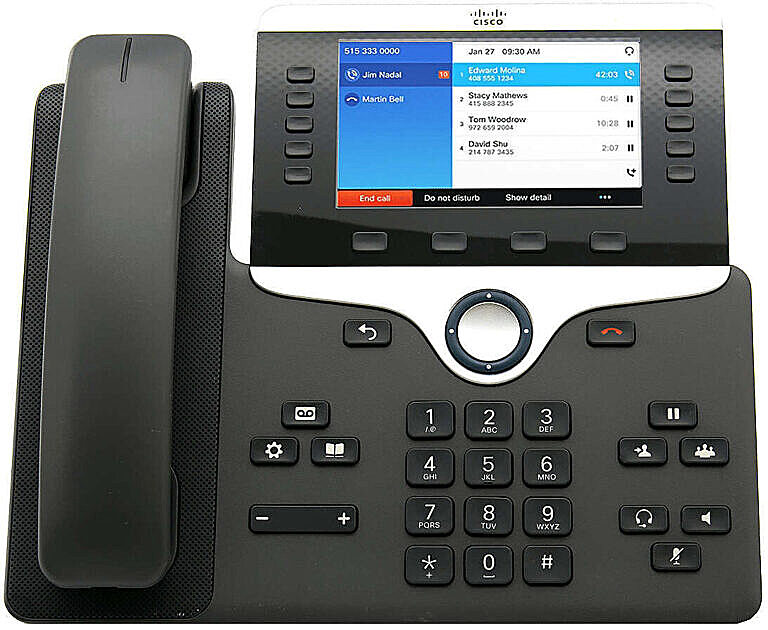The average VoIP phone isn’t that much different from the analogue phone you currently have at your desk or used to have at home. VoIP phones look the same and often have the same features as the landline desk phones you’re probably familiar with.
There are, however, some key differences that distinguish VoIP phones from other desk phones. This article will give you a quick overview of how a VoIP phone works and how to use one.
Registration Rewired: VoIP Phone Systems Don’t Need Expensive Copper Wire #
VoIP phones make and receive calls via the Internet. This means that it uses our office’s fibre internet connection to connect to the telephone network. In other words, we use the same Ethernet lines on walls as our offices, which are already wired to our central system. So we do not need additional copper wiring to use your desk phones, and this creates fewer cables all around as your computer and VoIP phone lines can communicate from the same Ethernet cables, switches, and routers.

In order to make phone calls, you will first have to register your VoIP phone with your account. This is the process of connecting your phone to your service provider so that they can communicate with each other. We already did that for you, and your desk phone is ready to be used.
Tip
The biggest advantage for you is that there’s no need to call the local phone company. Phones are active as soon as they’re registered with us. No red tape.
We still know how you can wait on the support line trying to talk to someone for hours, and you certainly gave up after the fourth person you talked to to fix your problem. Certainly, it is not that bad for all providers, but as you try to get the cheapest service possible, the support gets the same to get impossible as well.
This won’t happen with our VoIP service, as we are literally a few feet away from you.
VoIP Phones Look Just Like Regular Phones #
From an external perspective, it may be difficult to distinguish a VoIP phone from a traditional business desk phone. VoIP phones tend to have handsets, receivers, speaker locations, and button placements that make them physically indistinguishable from the business phones you currently employ.
VoIP phones use the same keypad as landline phones. The keypad comes with nine numbers, zeros, and corresponding letters that enable alphanumeric input. If you’ve ever used a phone before, you’ve seen this keypad.

VoIP phones generally have dedicated buttons for redial, transfer, conference, hold, mute, voicemail, and speakerphone. These buttons are set along the side of the number pad. VoIP phones and other business phones use these features almost universally. That said, VoIP phones are capable of HD voice, while other business phones are not.
HD Voice offers at least twice the audio range of landline phone service. The spread for landline voice quality is 3.4 kHz (3400 Hz), but the spread for HD voice is 7 kHz (7000 Hz). In other words, the quality of your calls will be much higher using two VoIP phones than two traditional phones.
Our VoIP phones also support Power over Ethernet (PoE), which allows you to power the phone through a PoE switch instead of a power adapter. This reduces clutter on your desk and simplifies inventory management. So we already power them from our central switch, and you do not need any hanging power adapters in your office.
The look is professional and high-end #
Indeed, VoIP phones may look quite high-tech too. They will certainly impress when your customers visit you.
If you are not satisfied with the one we installed at your office, we have updated new versions of those phones that you can lease for a small fee each month. They come with higher-quality screens, additional connection options like Bluetooth handsets, higher voice quality, etc.



One VoIP Phone Number, Multiple Phone “Lines” #
VoIP phones handle calls differently than other business phones. Above the buttons are the toggle buttons. VoIP phones allow you to pick between current, incoming, and held calls using the toggle buttons. These buttons rarely appear on landline phones.
On landline phones, each “line” corresponds to a phone number. Landline phones can juggle multiple calls among corresponding copper lines, and you switch between these calls with the line buttons (in the green rectangle above) on the phone. If you have five lines for your business, that means your phone can take calls from five different phone numbers.
VoIP phones, on the other hand, do not have “lines” in the traditional sense. Instead of being tied to a phone number, each ‘line’ on a VoIP phone is tied to a SIP address, or user account. Depending on your phone model, your phone may be able to handle multiple user accounts simultaneously. This means you can take calls from multiple accounts and different phone numbers on your VoIP phone.
VoIP vs Regular Phones: Similarities and Differences #
As you can see, VoIP phones and landline phones differ in how they are connected to the telephone network, how they operate, and how they handle calls. To recap, here are the main differences:
- VoIP phones use the Internet to connect to the phone network and need to be registered online to a service provider. Other business phones require dedicated copper wiring separate from an Ethernet connection.
- VoIP phones are tied to user accounts, not phone numbers. VoIP phones have “toggle buttons” that allow you to switch between simultaneous calls on a given account.
- VoIP phones are capable of HD voice, which has twice the audio range of traditional landline calls.
- Power over Ethernet (PoE) allows some VoIP phones to receive power from a PoE switch instead of a traditional power adapter.
But there are also plenty of similarities that VoIP phones share with other desk phones:
- VoIP phones use the same keypad as other desk phones.
- Like other office phones, VoIP phones have dedicated buttons for features such as call hold, call transfer, and caller ID.
- VoIP phones are physically similar in design to other business telephones.
- The basic deployment of handsets, receivers, speakers, and other structural items is the same for VoIP and landline phones.
The short of it all is this: If you’ve ever used an office phone before, you won’t have much trouble adjusting to a VoIP phone. Switching to VoIP phones won’t require you to completely relearn the way you take and make calls.
And we make it so easy for you at West Quay Offices. We or you can set up all of your systems. Everything is included.
Check our VoIP solutions and order today.








